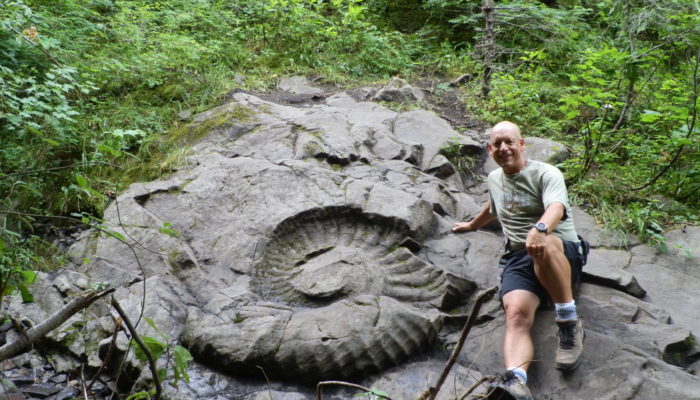
When I graduated in the 80’s, a job in oil and gas was seen as a glamorous and exciting career for a geoscientist. Even some dramatic falls in the oil price could not dent the optimism within the industry, and oil cities like Calgary thrived. However, life for geologists working in our city has changed dramatically over the last few years. A peak oil price of around $106 per barrel in June 2014 was followed by a fall to $27 a barrel in February 2016. Currently the price sits at around $40 per barrel, up from $16.94 in April 2020. It is estimated that, as a result, more than 1500 geoscientists are out of work in the city, and I have been let go four times in the last ten years. But this is no sob story: instead it is a chance to share what is possible when you have to get creative in a challenging (and indeed almost non existent) job market.
I set up my own consultancy in 2016, with the primary aim of running geological field trips for the oil and gas industry. We are extremely fortunate in Alberta to have a host of world class outcrops, many of which provide surface analogues to producing reservoirs underground. The overall stratigraphy comprises a carbonate dominated Palaeozoic section, passing up into clastic deposits dating from the Triassic to Paleocene in age. Most of my work has focused on the clastic sediments, and I have run over 40 field trips in Alberta over the last four years. This is also a great excuse to visit lots of outcrops to collect field data, log sections and see unusual geology like the featured giant ammonite which outcrops near Fernie, in British Columbia. I have also been awarded several research permits, allowing me to continue ongoing analyses within the World Heritage Site at Dinosaur Provincial Park and elsewhere.
The Park is located around two hours’ drive to the East of Calgary, which makes a nice change as most people “turn left” from the city and head West along the TransCanada Highway into the mountains. Heading East leads through rolling Prairies countryside, with the occasional sighting of deer and pronghorn antelope to break up the sometimes monotonous drive. I will never forget my first visit to the Park – after crossing many kilometres of relatively flat terrain, you crest a rise and look down into an antediluvian setting of badlands stretching into the distance. These eroded terrestrial deposits of the Campanian, Upper Cretaceous, have yielded one of the world’s richest dinosaur assemblages, still being studied at the Royal Tyrrell Museum in Drumheller. My research currently focuses on two aspects of the geology of the Park. I originally identified a meandering channel succession towards the top of the Oldman Formation, during research for my Masters thesis, noteworthy in a Formation formerly described as having been deposited by “braided rivers”. The point bar deposits are usually a striking rusty orange in colour over this interval, which makes it relatively straightforward to trace them around the Park. Following the methodology developed by Derald Smith (Durkin et al 2011) , I am mapping out the individual point bars within the “Orange Channel” to build up a snapshot of the channel distribution at one moment in geological time. This can then be compared to slices through 3-D seismic data collected in the subsurface of other Albertan Cretaceous fluvial deposits, as at Nexen’s Kinosis oil sands property (Hubbard et al 2011).
Due to other commitments, the project is slowly moving forward, and I am building a map of the point bars over a 6 square kilometre area in the Park’s core. The inclined heterolithic strata (IHS) are beautifully preserved, though not always accessible in the vertical faces of some of the outcrops. Very low dips also make it challenging to map out the orientations of the point bars, and I am using an app (Strike and Dip) to speed up the mapping process. I hope to complete the research in 2021. The second project examines microvertebrate sites across the Park to see whether different depositional settings lead to faunal variation that can be observed in surface collected material. Microvertebrate material consists of the smaller vertebrate elements such as teeth, claws, scales and bone fragments from dinosaurs, reptiles, amphibians and mammals. The material is concentrated by processes such as flooding (crevasse splays), as lags in channels, or in ponds, and is very valuable in providing an overview of the vertebrate faunal diversity. Ideally, once microvertebrate sites have been identified they are bulk collected, processed and sieved to ensure that nothing is missed, but even surface collecting can give a fair idea of the faunal assemblages. My work examines the differences in faunal assemblages from the depositional settings listed above, working mainly with dinosaur and other teeth, and with fish remains.
One of my philosophies when looking for work is to “throw a hundred darts at the board”, i.e. to look for diverse job opportunities, in the hope that one of those darts will stick in the board. This was why I successfully applied to become a “Consultant Palaeontologist of Alberta” earlier this year, with the aim of getting involved in site surveys and EIAs (Environmental Impact Assessments). As part of this process I got to visit a site in Livingstone, a new suburb on the northern margins of Calgary, to log some sedimentological sections and to help with palaeontological analysis of Paleocene sediments. My eye was immediately drawn to the fluvial sandstones of the Willow Creek Formation, but we concentrated our observations on the interbedded floodplain siltstones and mudstones above them and were rewarded with a beautiful little mammal jaw. It was from a tiny creature similar to a modern glider. Further hunting turned up more mammal teeth and a variety of fish remains. There were also lots of gastropods, presumably inhabiting ponds and creeks on the floodplain.
Consultancy is obviously not limited to running field trips and getting out to do field geology. Over the last four years I have also prepared many classroom courses and have taught various courses as a sessional instructor at the University of Alberta in Edmonton, and at Mount Royal University here in Calgary. Oil companies are also enthusiastic about core workshops, and I have given several on fluvial environments, incised valley fill and tidal deposits, and shoreface deposits. The Alberta Energy Regulator (AER) in Calgary has a world class core repository, with cores covering every Formation in the Province, and is a wonderful resource for viewing core. The paucity of turbidites in the Western Canada Sedimentary Basin (WCSB) makes courses on this setting less popular. Putting the core workshops together takes a lot of work, but is very rewarding, and it is fun designing exercises to help embed the learnings.
On the consulting side, I have worked on comparing Russian to Canadian stratigraphy, on helium exploration and on a variety of core logging projects. The most recent was looking at the Ellerslie Formation, a Lower Cretaceous Formation deposited in fluvio-estuarine and shoreface settings. Several cores intersected an incised valley fill of stacked meandering channels, while others bisected beach deposits full of Skolithos burrows (pipe rock), as well as coals, lagoons and tidal flats. The overlying Ostracod Beds are, unsurprisingly, full of ostracods and bivalve coquinas, interbedded with thick packages of open marine, black mudstone beds. I consider core logging as a real test of geological knowledge, interpreting complex stratigraphy based on a 4 inch diameter tube of data, even more so when the regional context is absent or the existing core and published data is sparse. All of the logged sections have to be plotted up and I use Adobe Illustrator and a template of my own devising. I am also experimenting with plotting core logs up in three dimensions.
- Trough cross-bedded fluvial sandstone seen in core from the Ellerslie Formation
- Three-dimensional image of logged section through Paleocene fluvial core
So clearly there is a lot to keep a (not so) young geologist busy in Alberta. I also mentor three graduate students, one of whom recently found a position in a laboratory in the Yukon, which is really exciting. In future blogs I am looking forward to sharing another passion, the Geology of Wine, which has led to engagements with the COOP, several oil companies and the Canadian Society of Petroleum Geologists (CSPG). I will also be explaining about my VFT Project, Virtual Field Trips which I am launching next week. Months of preparation will hopefully yield dividends while allowing industry and student geologists to (virtually) get out into the field – the slogan is “Better than being there”. Meanwhile all the best from a snowy Calgary and do stay healthy.
Editors note: references available upon request

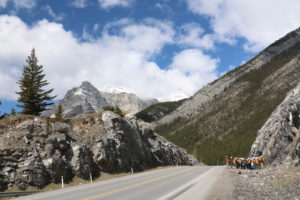
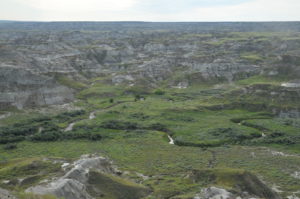
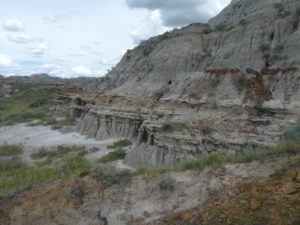
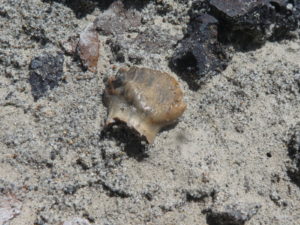
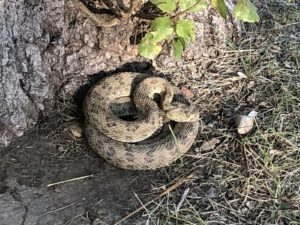
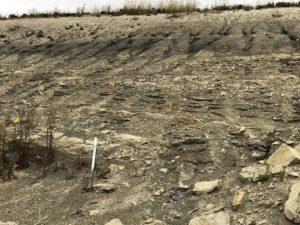
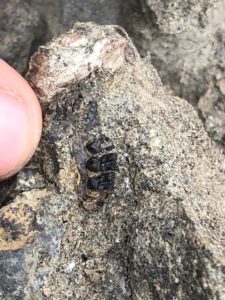
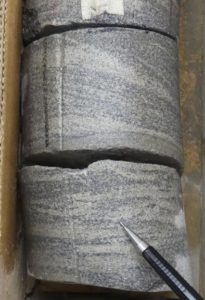
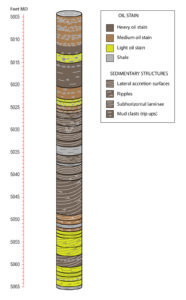
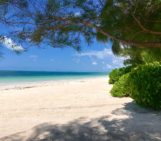
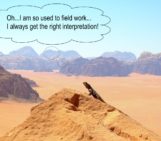
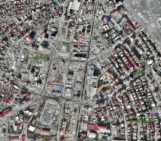
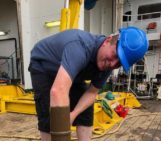
Doreen Bekoe
I have very much enjoyed reading this piece. I’m Doreen, a young geologist from Ghana- West Africa. I will appreciate it if videos or articles on the topic: VFT Project, Virtual Field Trips, could be shared with me. Thanks
Jon Noad
Thank you Doreen – there is an article on virtual field trips in the AAPG Explorer:
https://explorer.aapg.org/story/articleid/59652/virtual-field-trips-yield-real-life-results
you will need a log in to read it; let me know if you have any problems